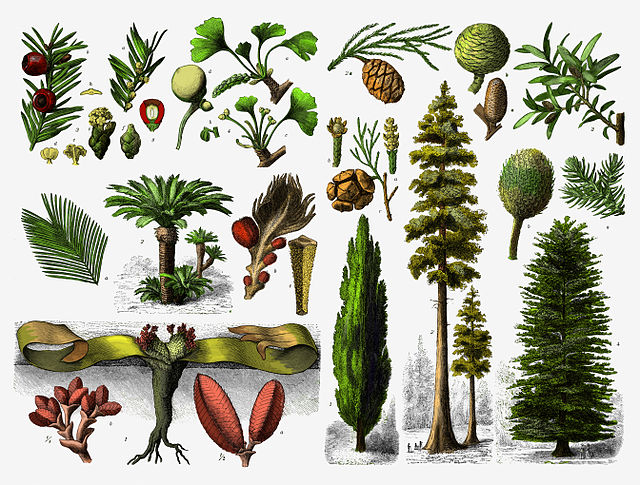The progymnosperms are an extinct group of woody, spore-bearing plants that is presumed to have evolved from the trimerophytes, and eventually gave rise to the gymnosperms, ancestral to acrogymnosperms and angiosperms. They have been treated formally at the rank of division Progymnospermophyta or class Progymnospermopsida. The stratigraphically oldest known examples belong to the Middle Devonian order the Aneurophytales, with forms such as Protopteridium, in which the vegetative organs consisted of relatively loose clusters of axes. Tetraxylopteris is another example of a genus lacking leaves. In more advanced aneurophytaleans such as Aneurophyton these vegetative organs started to look rather more like fronds, and eventually during Late Devonian times the aneurophytaleans are presumed to have given rise to the pteridosperm order, the Lyginopteridales. In Late Devonian times, another group of progymnosperms gave rise to the first really large trees known as Archaeopteris. The latest surviving group of progymnosperms is the Noeggerathiales, which persisted until the end of the Permian.

Progymnosperm
The gymnosperms are a group of seed-producing plants that includes conifers, cycads, Ginkgo, and gnetophytes, forming the clade Gymnospermae. The term gymnosperm comes from the composite word in Greek: γυμνόσπερμος, literally meaning 'naked seeds'. The name is based on the unenclosed condition of their seeds. The non-encased condition of their seeds contrasts with the seeds and ovules of flowering plants (angiosperms), which are enclosed within an ovary. Gymnosperm seeds develop either on the surface of scales or leaves, which are often modified to form cones, or on their own as in yew, Torreya, Ginkgo. Gymnosperm lifecycles involve alternation of generations. They have a dominant diploid sporophyte phase and a reduced haploid gametophyte phase which is dependent on the sporophytic phase. The term "gymnosperm" is often used in paleobotany to refer to all non-angiosperm seed plants. In that case, to specify the modern monophyletic group of gymnosperms, the term Acrogymnospermae is sometimes used.

Gymnosperm
Encephalartos sclavoi cone, about 30 cm long
Zamia integrifolia, a cycad native to Florida




